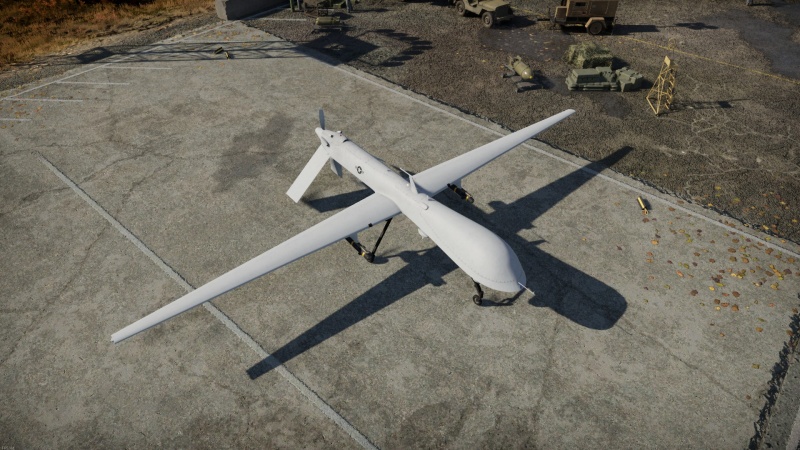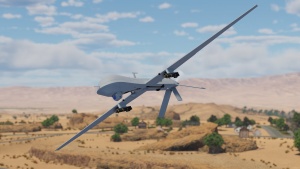MQ-1
Contents
Description
In the mid-1990s, General Atomics Aeronautical Systems was awarded a contract to build a new UCAV (Unmanned Combat Aerial Vehicle) for the US military, designated "RQ-1". Developed from the General Atomics Gnat 750, the "Predator", as the RQ-1 was named, would go on to serve in many conflicts around the world, including in Bosnia, Yugoslavia, Afghanistan, Iraq, and Libya, starting in 1995. It filled the role of remote reconnaissance and surveillance. After the drone was successfully tested carrying Hellfire missiles in 2001, the RQ-1 would also participate in the strike role, thereafter being redesignated as the "MQ-1". The RQ/MQ-1 Predator served extensively with the US military from 1995 until 2018, after which it was pulled out of service and replaced by the larger and more capable General Atomics MQ-9 "Reaper".
Introduced in Update "Drone Age", the MQ-1 is not researchable and is only accessible for players in high-tier ground battles, costing 750 Spawn Points to spawn. All in-game nations have access to this drone, except for the USSR and China, who instead use the Orion and Wing Loong I respectively. The MQ-1 is useful in cases where other CAS is unavailable or unable to be used, for example, in night ground battles where players can take advantage of the MQ-1's thermal imaging. Due to its relatively limited arsenal and low top speed, players are recommended to use the MQ-1 conservatively and as far away from the battlefield as possible to stay clear of enemy SPAA. After the drone's armament is expended, it can be used to locate enemy vehicles for the team with its excellent optical zoom and thermals.
General info
Flight performance
| Max speed (km/h at 1,000 m) |
Max altitude (metres) |
Turn time (seconds) |
Rate of climb (metres/second) |
Take-off run (metres) | |||
|---|---|---|---|---|---|---|---|
| AB | RB | AB | RB | AB | RB | ||
| 220 | 220 | 22.0 | 22.0 | 2.5 | 2.5 | 250 | |
Details
| Features | ||||
|---|---|---|---|---|
| Combat flaps | Take-off flaps | Landing flaps | Air brakes | Arrestor gear |
| X | X | X | X | X |
| Limits | ||||||
|---|---|---|---|---|---|---|
| Wings (km/h) | Gear (km/h) | Flaps (km/h) | Max Static G | |||
| Combat | Take-off | Landing | + | - | ||
| 390 | N/A | N/A | N/A | ~__ | ~__ | |
| Optimal velocities (km/h) | |||
|---|---|---|---|
| Ailerons | Rudder | Elevators | Radiator |
| < ___ | < ___ | < ___ | > ___ |
Survivability and armour
Aircraft survivability is an issue with most drone types, with drones having low top speeds and sluggish manoeuvrability. The structural integrity of the MQ-1 is subpar, with even simple rifle-calibre machine guns being able to take it out. Larger weapons will do significant damage to the drone, especially its fragile wings and unarmoured body. The MQ-1 does not carry countermeasures, so it will not be able to effectively defend against incoming surface-to-air missiles.
One benefit of drones is that, due to them being unmanned, the aircraft can sustain excessive G forces without a pilot blacking out.
Armaments
Suspended armament
The MQ-1 can be outfitted with the following ordnance:
- 2 x AGM-114K Hellfire II missiles
Usage in battles
As the MQ-1 has a limited payload, it is advised to use the drone for reconnaissance rather than to destroy the first two targets you see. This will ensure that your team is able to identify and deal with threats as best they can, while using the drone's weapons as backup in case of emergency situations. The MQ-1's slow speed will actually improve its performance in this role, as it will be able to act as a constant "eye in the sky" with its long loiter time.
Target Designation and Reconnaissance
The MQ-1 is equipped with a highly effective targeting pod, boasting thermal vision and enhanced zoom. This allows the operator to scout targets from a long distance, then relay information to ground forces or close air support elements. Some important information that a drone operator can provide to the team are the location and movement of enemy ground vehicles, activity at enemy helipads, and the presence of incoming aircraft. Using the MQ-1 to survey the battlefield and relay targets is a tried and tested way of helping the team hold and capture objectives, critical for winning the game.
SEAD (Suppression of Enemy Air Defence)
Due to the MQ-1's ability to somewhat hide from radar (due to its small size and high altitude), it can be used to destroy enemy ground-based anti-aircraft systems. This ensures that more well-armed allies, such as the AH-64 Apache or the A-10 Thunderbolt II, can operate more freely as there are fewer air defence systems in place to destroy them. Clearing the way for close air support can help them clear the ground and ensure victory.
Redeployment and Withdrawal
Due to the nature of the MQ-1's mid-air spawning and slow speed, it is extremely slow to rearm the vehicle. The speed of the MQ-1 can be compared to biplane aircraft. It is often more cost-effective to abandon the vehicle after the user has felt that its purpose has been served. That being said, the redeployment of the vehicle is possible in the sense that the MQ-1 can orbit different parts of a map. The MQ-1 has no problems climbing and gaining altitude, able to change areas of surveillance and relay further information to the team.
Pros and cons
Pros:
- Hellfire missiles are accurate and can be used at long ranges
- Can carry a lot of fuel, meaning a long loiter time
- Has extremely high visibility of the whole battlefield with excellent thermal targeting pod
- Small size can make it hard for enemies to detect and intercept at high altitudes
- Quiet propeller engine
- Tight turn radius with vertical pitch
- Unmanned, does not suffer loss of pilot consciousness during high G manoeuvres
- Spawns close to the battlefield
Cons:
- Limited weapon payload
- Slow, can make rearming and returning to battle impractical
- Unarmoured, components are extremely vulnerable to enemy fire
- No countermeasures
- Poor roll rate and negative pitch control
- Hellfire targeting is limited to a downward angle in front of the drone, but not directly below
- High spawn cost compared to other aircraft with equal or better payloads
History
The MQ-1 Predator was an unmanned aerial vehicle developed by General Atomics for the USAF in the 1990s. General Atomics was selected for the development of the aircraft in 1994 with its first flight on the 3rd July 1994 at El Mirage Airfield in the Mojave Desert. The aircraft was derived from the General Atomics Gnat 750, which was a reconnaissance drone developed in the late 1980s.
The drone participated in a few exercises in 1995 as part of its ACTD (Advanced Concept Technology Demonstration). In this stage, it was flown by members of the US Navy, Air Force, Army, and Marine Corps with successful results.
This led to the decision to deploy the RQ-1 in 1995 as part of peacekeeping missions in the Balkans, thus it was deployed in Albania and former Yugoslavia. Its first deployment en masse was during the War in Afghanistan in 2001. At that point, the US had 60 Predators in service but 20 were lost in action during the conflict. Reportedly, most of these losses were not due to enemy fire, instead due to reliability problems. The drone struggled with icy and cold weather conditions, which are normal in the mountains of Afghanistan. Thus, the aircraft's development continued, incorporating a de-icing system, upgraded turbocharger, and improved avionics in what was called the Block 1 or MQ-1L.
Its armed version incorporated pylons for guided ammunition such as the Hellfire ATGM. Several tests were carried out during the early 2000s with good results and several simulated targets being destroyed. These Predator models were put into service with the designation MQ-1A. Other tests occurred during 2001 after the CIA advocated to use the Hellfire armed version of the Predator to target high-value targets like Osama Bin Laden, leader of the Al-Qaeda terrorist organisation. However, these tests showed mixed results because of issues with the missile fuze that were later resolved.
In 2002, the Italian Armed Forces signed a contract for 6 x MQ-1A Predator drones in 2002 with the units being delivered in 2004. These units were used in Afghanistan, Djibouti and Iraq with more than 8,000 hours of flight until their retirement in 2022. Licenses for its sale were also given to Saudi Arabia, the UAE, Morocco and Egypt.
Starting in 2004, the Royal Air Force operated the MQ-1 Predator with No.39 Squadron RAF based at Creech Air Force Base, Nevada, USA as part of the Joint Predator Task Force. They would fly their drones in action in conflicts in Afghanistan and Syria.
The Predator as a platform showed good results, being the main UAV in service with the USAF and other branches of the US Armed Forces until the arrival of the MQ-9 Reaper, which was itself a further development of the MQ-1. The aircraft was deployed to the Balkans, Afghanistan, Pakistan, Iraq, Yemen, Libya, Syria and several other locations where it was used not only in military operations but also as a counter-terrorist weapon. Because of its unmanned nature, it was often safer to use drones like the Predator to find and execute targets from afar without risking the lives of pilots or ground forces in the process.
The Predator remained in limited US service up to 2018 when it was completely retired in favour of the MQ-9 Reaper.
Media
See also
Other Strike UCAVs:
External links
| General Atomics Aeronautical Systems, Inc. (GA-ASI) | |
|---|---|
| Drones | MQ-1 |
| Strike UCAVs | |
|---|---|
| USA | MQ-1 |
| USSR | Orion |
| China | Wing Loong I |






